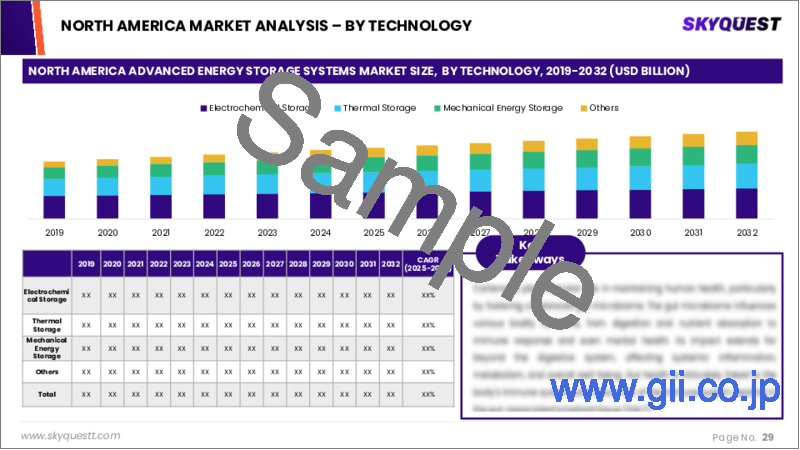|
|
市場調査レポート
商品コード
1677976
先進エネルギー貯蔵システムの市場規模、シェア、成長分析:技術別、用途別、エンドユーザー別、地域別 - 産業予測 2025~2032年Advanced Energy Storage Systems Market Size, Share, and Growth Analysis, By Technology (Electro Chemical, Mechanical), By Application (Transportation, Grid Storage), By End User, By Region - Industry Forecast 2025-2032 |
||||||
|
|||||||
| 先進エネルギー貯蔵システムの市場規模、シェア、成長分析:技術別、用途別、エンドユーザー別、地域別 - 産業予測 2025~2032年 |
|
出版日: 2025年03月05日
発行: SkyQuest
ページ情報: 英文 178 Pages
納期: 3~5営業日
|
全表示
- 概要
- 目次
先進エネルギー貯蔵システム市場規模は2023年に20億米ドルと評価され、予測期間(2025~2032年)のCAGRは6.9%で、2024年の21億4,000万米ドルから2032年には36億5,000万米ドルに成長する見通しです。
世界の先進エネルギー貯蔵システム市場は、電気自動車需要の高まりと再生可能エネルギーへの大幅な投資によって大きく成長する見通しです。市場を牽引する主要な要因としては、電力網と近代的なインフラの急速な拡大、そして省エネ意識の高まりに伴う太陽光発電所の設置数の増加などが挙げられます。CO2排出や温室効果ガスに対する環境問題への懸念から、先進国も新興国も、風力、水力、太陽光などの再生可能エネルギー発電を発電戦略に組み込む動きを強めています。再生可能エネルギー生産を強化するための継続的な政府の取り組みと投資は、エネルギー効率と省エネルギーへの焦点と相まって、新たな成長の道を切り開き、予測期間中の市場見通しを高めると予想されます。
目次
イントロダクション
- 調査の目的
- 調査範囲
- 定義
調査手法
- 情報調達
- 二次と一次データの方法
- 市場規模予測
- 市場の前提条件と制限
エグゼクティブサマリー
- 世界市場の見通し
- 供給と需要の動向分析
- セグメント別機会分析
市場力学と見通し
- 市場概要
- 市場規模
- 市場力学
- 促進要因と機会
- 抑制要因と課題
- ポーターの分析
主な市場の考察
- 重要成功要因
- 競合の程度
- 主な投資機会
- 市場エコシステム
- 市場の魅力指数(2024年)
- PESTEL分析
- マクロ経済指標
- バリューチェーン分析
- 価格分析
先進エネルギー貯蔵システム市場規模:技術別
- 市場概要
- 電気化学
- リチウムイオン電池
- 鉛蓄電池
- ナトリウム硫黄(NaS)電池
- フロー電池
- ニッケル水素(NiMH)とニッケルカドミウム(NiCd)
- 機械
- 揚水発電
- フライホイール
- 圧縮空気エネルギー貯蔵(CAES)と液体空気エネルギー貯蔵(LAES)
- 蓄熱
- 熱化学
- 顕熱
- 潜熱
先進エネルギー貯蔵システム市場規模:用途別
- 市場概要
- 輸送
- グリッド貯蔵
先進エネルギー貯蔵システム市場規模:エンドユーザー別
- 市場概要
- 住宅用
- 非住宅用
先進エネルギー貯蔵システム市場規模
- 北米
- 米国
- カナダ
- 欧州
- ドイツ
- スペイン
- フランス
- 英国
- イタリア
- その他欧州地域
- アジア太平洋地域
- 中国
- インド
- 日本
- 韓国
- その他アジア太平洋地域
- ラテンアメリカ
- ブラジル
- その他ラテンアメリカ地域
- 中東・アフリカ
- GCC諸国
- 南アフリカ
- その他中東・アフリカ
競合情報
- 上位5社の比較
- 主要企業の市場ポジショニング(2024年)
- 主な市場企業が採用した戦略
- 最近の市場動向
- 企業の市場シェア分析(2024年)
- 主要企業の企業プロファイル
- 企業の詳細
- 製品ポートフォリオ分析
- 企業のセグメント別シェア分析
- 収益の前年比比較(2022~2024年)
主要企業プロファイル
- Tesla, Inc.(USA)
- LG Energy Solution(South Korea)
- Contemporary Amperex Technology Co., Ltd.(CATL)(China)
- Panasonic Holdings Corporation(Japan)
- Samsung SDI Co., Ltd.(South Korea)
- BYD Company Limited(China)
- Fluence(USA)
- Siemens Energy(Germany)
- General Electric Company(GE)(USA)
- Eaton Corporation(Ireland)
- ABB Ltd.(Switzerland)
- Toshiba Corporation(Japan)
- Saft Groupe S.A.(France)
- NEC Energy Solutions(USA)
- Sonnen GmbH(Germany)
- Leclanche SA(Switzerland)
- Enphase Energy, Inc.(USA)
- Microvast Holdings, Inc.(USA)
- Powin LLC(USA)
結論と提言
Advanced Energy Storage Systems Market size was valued at USD 2.0 billion in 2023 and is poised to grow from USD 2.14 billion in 2024 to USD 3.65 billion by 2032, growing at a CAGR of 6.9% during the forecast period (2025-2032).
The global advanced energy storage systems market is poised for significant growth driven by the rising demand for electric vehicles and substantial investments in renewable energy. Key market catalysts include the rapid expansion of electrical grids and modern infrastructure, alongside a growing number of solar farm installations influenced by heightened awareness of energy conservation. In response to environmental concerns over CO2 emissions and greenhouse gases, both developed and emerging nations are increasingly integrating renewable energy sources like wind, hydro, and solar into their power generation strategies. Continued government initiatives and investments to bolster renewable energy production, coupled with a focus on energy efficiency and conservation, are expected to create new growth avenues and enhance market prospects in the forecast period.
Top-down and bottom-up approaches were used to estimate and validate the size of the Advanced Energy Storage Systems market and to estimate the size of various other dependent submarkets. The research methodology used to estimate the market size includes the following details: The key players in the market were identified through secondary research, and their market shares in the respective regions were determined through primary and secondary research. This entire procedure includes the study of the annual and financial reports of the top market players and extensive interviews for key insights from industry leaders such as CEOs, VPs, directors, and marketing executives. All percentage shares split, and breakdowns were determined using secondary sources and verified through Primary sources. All possible parameters that affect the markets covered in this research study have been accounted for, viewed in extensive detail, verified through primary research, and analyzed to get the final quantitative and qualitative data.
Advanced Energy Storage Systems Market Segments Analysis
Global Advanced Energy Storage Systems Market is segmented by Technology, Application, End User and region. Based on Technology, the market is segmented into Electro Chemical, Mechanical and Thermal Storage. Based on Application, the market is segmented into Transportation and Grid Storage. Based on End User, the market is segmented into Residential and Non-Residential. Based on region, the market is segmented into North America, Europe, Asia Pacific, Latin America and Middle East & Africa.
Driver of the Advanced Energy Storage Systems Market
The expansion of the Advanced Energy Storage Systems market is being fueled by evolving energy policies in both developed and developing countries, which are increasingly prioritizing power generation from renewable sources such as wind and solar. Government incentives and attractive returns on investments in renewable energy are significantly boosting financial commitments in this sector. Additionally, there is a critical need to modernize and enhance electricity grids to accommodate renewable energy integration. Recent trends indicate that the costs associated with geothermal, hydropower, biomass, and onshore wind energy are now competitive with conventional gas, oil, and coal power plants. These developments are expected to drive substantial growth in the advanced energy storage systems industry over time.
Restraints in the Advanced Energy Storage Systems Market
The Advanced Energy Storage Systems market faces significant challenges due to the high capital requirements associated with the production of technologies like lithium-ion, flow, and sodium-sulfur batteries. The elevated cost of lithium, a primary raw material, consequently drives up the expense of lithium-ion batteries. Initially, technology costs are expected to remain high in the early phases of lithium's application in electric vehicles and grid storage. However, with growing adoption, there is a potential for cost reductions over time. Additionally, as the rated power capacity increases, the technology expenses escalate, potentially hindering the growth of the advanced energy storage systems market in the near future.
Market Trends of the Advanced Energy Storage Systems Market
The Advanced Energy Storage Systems market is experiencing significant growth, driven by the increasing demand for efficient and sustainable energy solutions. Among the leading technologies, advanced lithium-ion batteries are gaining traction due to their portability, fast charging capabilities, and versatility in various applications. However, concerns about their flammability, sensitivity to temperature, and environmental impact from raw material mining are prompting innovative solutions like those from Singapore's Green Li-ion. This start-up's advanced recycling process enhances cathode purity while minimizing production time, offering an eco-friendly alternative that aligns with global sustainability goals. As such advancements emerge, the market is poised for transformative growth fueled by both technological innovation and rising awareness of ecological impacts.
Table of Contents
Introduction
- Objectives of the Study
- Scope of the Report
- Definitions
Research Methodology
- Information Procurement
- Secondary & Primary Data Methods
- Market Size Estimation
- Market Assumptions & Limitations
Executive Summary
- Global Market Outlook
- Supply & Demand Trend Analysis
- Segmental Opportunity Analysis
Market Dynamics & Outlook
- Market Overview
- Market Size
- Market Dynamics
- Drivers & Opportunities
- Restraints & Challenges
- Porters Analysis
- Competitive rivalry
- Threat of substitute
- Bargaining power of buyers
- Threat of new entrants
- Bargaining power of suppliers
Key Market Insights
- Key Success Factors
- Degree of Competition
- Top Investment Pockets
- Market Ecosystem
- Market Attractiveness Index, 2024
- PESTEL Analysis
- Macro-Economic Indicators
- Value Chain Analysis
- Pricing Analysis
Global Advanced Energy Storage Systems Market Size by Technology & CAGR (2025-2032)
- Market Overview
- Electro Chemical
- Lithium-ion battery
- Lead Acid battery
- Sodium Sulfur (NaS) battery
- Flow battery
- Nickel Metal Hydride (NiMH) & Nickel Metal Cadmium (NiCd)
- Mechanical
- Pumped Hydro
- Flywheel
- Compressed Air Energy Storage (CAES) & Liquid Air Energy Storage (LAES)
- Thermal Storage
- Thermo Chemical
- Sensible
- Latent
Global Advanced Energy Storage Systems Market Size by Application & CAGR (2025-2032)
- Market Overview
- Transportation
- Grid Storage
Global Advanced Energy Storage Systems Market Size by End User & CAGR (2025-2032)
- Market Overview
- Residential
- Non-Residential
Global Advanced Energy Storage Systems Market Size & CAGR (2025-2032)
- North America (Technology, Application, End User)
- US
- Canada
- Europe (Technology, Application, End User)
- Germany
- Spain
- France
- UK
- Italy
- Rest of Europe
- Asia Pacific (Technology, Application, End User)
- China
- India
- Japan
- South Korea
- Rest of Asia-Pacific
- Latin America (Technology, Application, End User)
- Brazil
- Rest of Latin America
- Middle East & Africa (Technology, Application, End User)
- GCC Countries
- South Africa
- Rest of Middle East & Africa
Competitive Intelligence
- Top 5 Player Comparison
- Market Positioning of Key Players, 2024
- Strategies Adopted by Key Market Players
- Recent Developments in the Market
- Company Market Share Analysis, 2024
- Company Profiles of All Key Players
- Company Details
- Product Portfolio Analysis
- Company's Segmental Share Analysis
- Revenue Y-O-Y Comparison (2022-2024)
Key Company Profiles
- Tesla, Inc. (USA)
- Company Overview
- Business Segment Overview
- Financial Updates
- Key Developments
- LG Energy Solution (South Korea)
- Company Overview
- Business Segment Overview
- Financial Updates
- Key Developments
- Contemporary Amperex Technology Co., Ltd. (CATL) (China)
- Company Overview
- Business Segment Overview
- Financial Updates
- Key Developments
- Panasonic Holdings Corporation (Japan)
- Company Overview
- Business Segment Overview
- Financial Updates
- Key Developments
- Samsung SDI Co., Ltd. (South Korea)
- Company Overview
- Business Segment Overview
- Financial Updates
- Key Developments
- BYD Company Limited (China)
- Company Overview
- Business Segment Overview
- Financial Updates
- Key Developments
- Fluence (USA)
- Company Overview
- Business Segment Overview
- Financial Updates
- Key Developments
- Siemens Energy (Germany)
- Company Overview
- Business Segment Overview
- Financial Updates
- Key Developments
- General Electric Company (GE) (USA)
- Company Overview
- Business Segment Overview
- Financial Updates
- Key Developments
- Eaton Corporation (Ireland)
- Company Overview
- Business Segment Overview
- Financial Updates
- Key Developments
- ABB Ltd. (Switzerland)
- Company Overview
- Business Segment Overview
- Financial Updates
- Key Developments
- Toshiba Corporation (Japan)
- Company Overview
- Business Segment Overview
- Financial Updates
- Key Developments
- Saft Groupe S.A. (France)
- Company Overview
- Business Segment Overview
- Financial Updates
- Key Developments
- NEC Energy Solutions (USA)
- Company Overview
- Business Segment Overview
- Financial Updates
- Key Developments
- Sonnen GmbH (Germany)
- Company Overview
- Business Segment Overview
- Financial Updates
- Key Developments
- Leclanche SA (Switzerland)
- Company Overview
- Business Segment Overview
- Financial Updates
- Key Developments
- Enphase Energy, Inc. (USA)
- Company Overview
- Business Segment Overview
- Financial Updates
- Key Developments
- Microvast Holdings, Inc. (USA)
- Company Overview
- Business Segment Overview
- Financial Updates
- Key Developments
- Powin LLC (USA)
- Company Overview
- Business Segment Overview
- Financial Updates
- Key Developments





